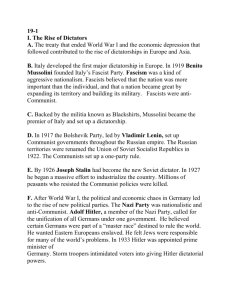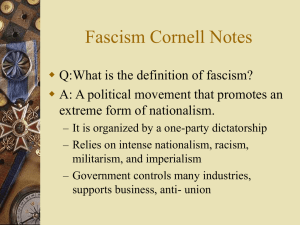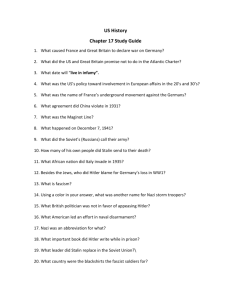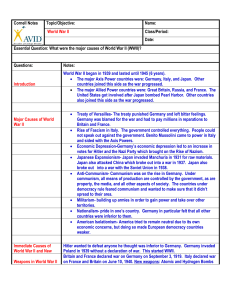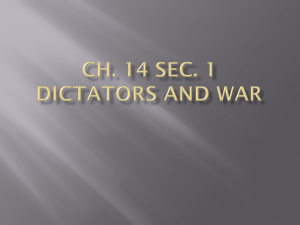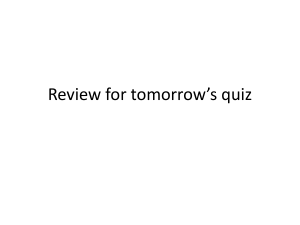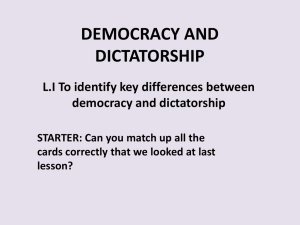Chapter 16: World War Looms Section 1
advertisement
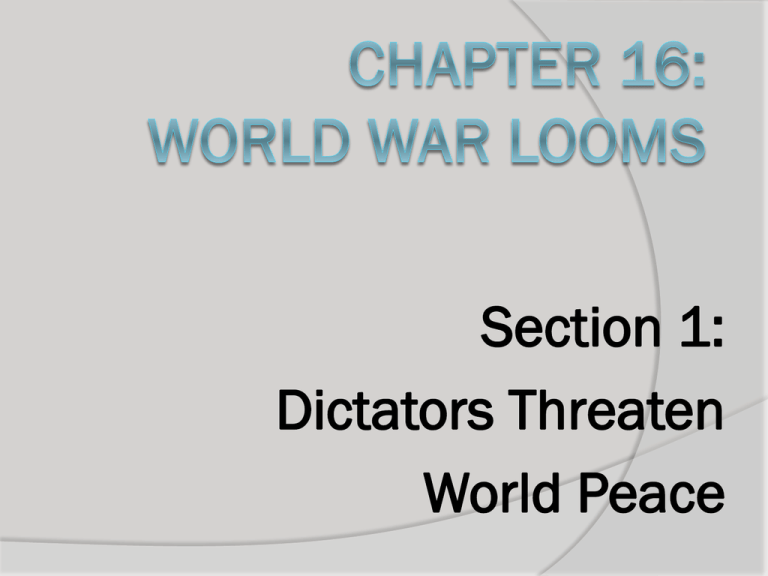
Section 1: Dictators Threaten World Peace Why had the Treaty of Versailles created anger and resentment in many nations? • Economic depression caused revolutions in Europe • Germany resented post WW I treatment •Soviets resented losing territory These problems encouraged people to turn to dictators to solve problems. Russia (The Soviet Union) I. I. Problems from World War I A. Civil War (communists vs. non-communists) B. Loss of territory. (map) New Leader: Joseph Stalin (1924) A. System – Communist dictatorship. B. Goals 1. Industrialize the Soviet Union. 2. Expand Soviet power. 3. Increase agricultural output. Russia (The Soviet Union) C. Methods 1. Govt. took total control of industry and farming. 2. Destroyed political opponents. 3. Took away individual freedoms. D. Aggressive actions in 1930s? - None really. Stalin was focused on establishing communism and modernizing Russia first. Italy Problems from World War I A. Unemployment and inflation. B. Fear of communism. II. New Leader: Benito Mussolini (1922) A. System – fascist dictatorship. B. Goals 1. Restore order in Italy. 2. Achieve greatness for Italy. C. Aggressive Actions 1. Invaded Ethiopia to establish colonial empire. 2. Supported fascists in Spanish Civil War. I. Germany Problems from World War I A. Unemployment and inflation. B. Anger over Treaty of Versailles. C. Longing for a “place in the sun.” D. Fear of communism. II. New Leader: Adolph Hitler (1933) A. System – fascist dictatorship. B. Goals 1. Restore order in Germany. 2. Avenge loss in World War I. 3. Create great German empire 3. Eliminate “Jewish problem.” I. Germany C. Aggressive Actions 1. Pulled out of League of Nations (1933). 2. Rebuilt German military. 3. Sent troops into the Rhineland. (1936) 4. Annexed Austria (1938) 5. Insisted on taking western Czechoslovakia. (1938) Book burning rallies… A Nuremberg Rally http://www.youtube.com/watch?v=ilXVkgmJk2E “How fortunate for leaders that men do not think.” - A. Hitler 1936 The Rome- Berlin Axis… The Third Reich The term “Third Reich” is used to describe Hitler’s Nazi regime in Germany from 1933 to 1945. Spain I. New Leader: General Francisco Franco (1939) A. System: fascist dictatorship. B. Goals 1. Create fascist dictatorship in Spain. C. Aggressive Actions 1. Led a rebellion against Spanish govt. 2. Became the Spanish Civil War a. fascists vs. non-fascists (including socialists and communists) b. Germany and Italy supported the fascists. c. The Soviet Union and some Americans supported the non-fascists. Guernica d. Became a testing ground for the German military. e. Fascists won. Japan I. Problems from World War I A. Lack of land and natural resources. II. New Leader: Hideki Tojo (1941) A. System: Military dictatorship (similar to fascism) B. Goals: 1. Create Japanese empire in the Pacific. 2. Secure natural resources for Japan. C. Aggressive Actions: 1. Invaded Manchuria in 1931. 2. Invaded rest of China in 1937. 3. Took French and British colonies in S.E. Asia. Objective… Describe America’s foreign policy in response to events in Europe in the 1930s.
